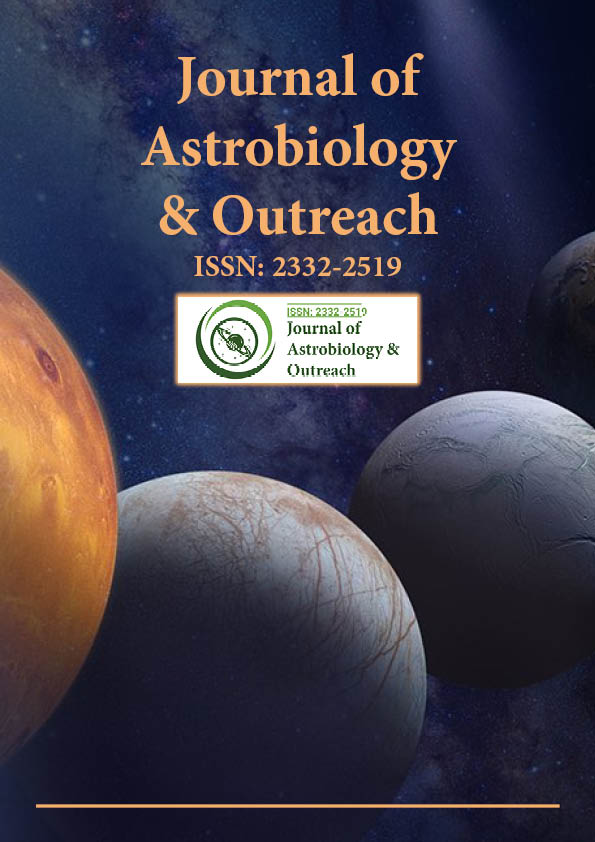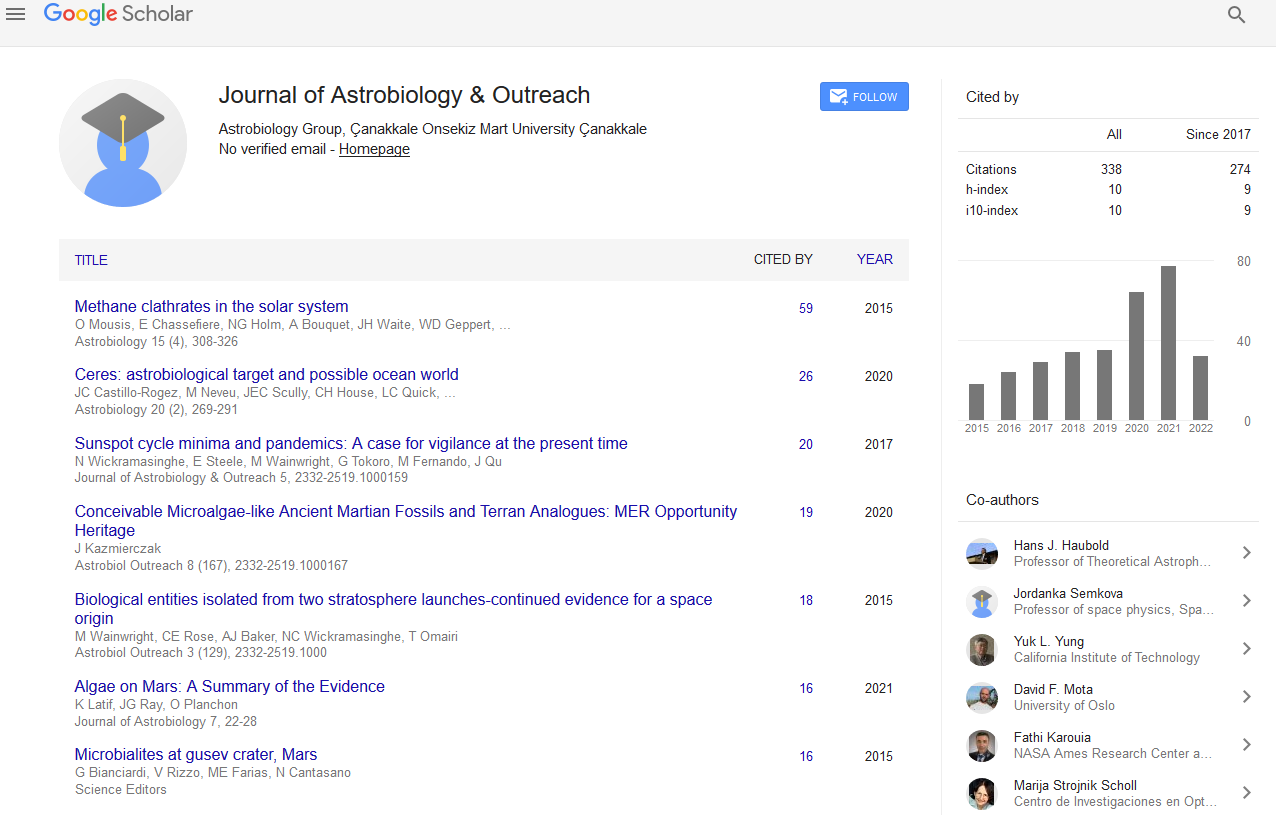Indexed In
- Open J Gate
- Academic Keys
- JournalTOCs
- RefSeek
- Hamdard University
- EBSCO A-Z
- OCLC- WorldCat
- Google Scholar
Useful Links
Share This Page
Journal Flyer

Open Access Journals
- Agri and Aquaculture
- Biochemistry
- Bioinformatics & Systems Biology
- Business & Management
- Chemistry
- Clinical Sciences
- Engineering
- Food & Nutrition
- General Science
- Genetics & Molecular Biology
- Immunology & Microbiology
- Medical Sciences
- Neuroscience & Psychology
- Nursing & Health Care
- Pharmaceutical Sciences
Opinion Article - (2024) Volume 12, Issue 2
Impacts and Core Evolution Revealed By IIG and IIAB Meteorite Compositions
Nicolas Kleine*Received: 28-May-2024, Manuscript No. JAO-24-27370; Editor assigned: 31-May-2024, Pre QC No. JAO-24-27370 (PQ); Reviewed: 14-Jun-2024, QC No. JAO-24-27370; Revised: 21-Jun-2024, Manuscript No. JAO-24-27370 (R); Published: 28-Jun-2024, DOI: 10.35248/2332-2519.24.12.349
Description
Iron meteorites, especially those classified as IIG and IIAB; provide a unique glimpse into the history of our solar system. These meteorites likely come from differentiated parent bodies that formed early on and they help reveal the conditions and processes that shaped the early planets and planetesimals. Analyzing their chemical and isotopic compositions enables scientists to piece together the origin and differentiation events that separated metal and silicate phases in these bodies, providing insights into the environments in which they developed. The IIG and IIAB iron meteorite groups are distinct, primarily in their chemical compositions and textures, pointing to separate origins and unique formation conditions. IIG meteorites are rare, characterized by high nickel and phosphorus levels but very low sulfur, which hints that they formed in environments where sulfur didn’t significantly influence the separation of metal and silicate phases. In contrast, IIAB meteorites have lower nickel content and often contain silicate mineral inclusions, suggesting they formed under different cooling rates and in sulfur-rich conditions. This contrast underscores the diversity of planetary bodies in the early solar system, each shaped by specific conditions that led to varied metal-silicate differentiation.
The high nickel and phosphorus levels in IIG meteorites suggest a cooling metallic core where such elements concentrated as the metal cooled and crystallized. In molten planetary cores, nickel and phosphorus migrate to specific areas, resulting in compositions like those seen in IIG meteorites. Additionally, the lack of sulfur indicates that the IIG parent body likely had a limited sulfur supply, differentiating its evolution from sulfurrich bodies. Studying these traits allows researchers to understand core formation processes and the cooling and crystallization of metallic cores within planetary bodies. IIAB meteorites, on the other hand, contain silicate inclusions and less nickel, suggesting a more sulfur-rich parent body where conditions allowed for troilite (iron sulfide) formation as the core cooled. This sulfur-rich environment affected crystallization, enabling silicate minerals to embed in the iron structure. The differences in sulfur and silicate content between IIG and IIAB meteorites imply that the original material in their parent bodies varied significantly, as did the conditions of pressure and temperature that influenced their formation. This further indicates that a variety of environments existed within the early solar system.
One prevailing theory for the formation of IIG and IIAB meteorite groups is that large impacts triggered the heating and differentiation of their parent bodies. These impacts likely produced enough heat to melt and separate heavy metals from lighter silicates, creating a metallic core. During cooling, distinct chemical and isotopic signatures would have formed in the core, marking the meteorites as unique products of specific planetary processes. Such impacts would also have fragmented these bodies, dispersing meteorites that eventually made their way to Earth. To estimate cooling rates in IIG and IIAB meteorites, scientists examine the crystalline structures within them. The presence of Widmanstätten patterns distinctive, interlocking structures of iron and nickel crystals reveals a lot about their cooling history. These patterns form only under very slow cooling conditions, requiring millions of years for complete crystallization. The gradual cooling suggests that the parent bodies of these meteorites were massive, allowing for extended heat retention and slow temperature dissipation.
Trace elements such as gallium, germanium and iridium offer further information about the conditions under which these meteorites formed. The unique ratios of these elements can indicate the environments in which they crystallized. For example, IIG meteorites, which tend to contain low amounts of gallium and germanium, likely formed in a sulfur-poor environment, while IIAB meteorites exhibit higher quantities of these elements, pointing to a sulfur-rich environment. Such analysis provides deeper insights into the chemistry of the parent bodies, revealing how these elements were distributed during cooling and crystallization. The origins of IIG and IIAB meteorites help refine existing theories about planetary core formation. By studying their unique properties, piece together a timeline of core crystallization and differentiate between parent bodies based on their chemistry and isotopic signatures. Each new piece of data improves the model of planetary core formation, which in turn informs our understanding of Earth and other planets’ development. Additionally, by observing these meteorites, scientists gain insight into the role of planetary cores in maintaining magnetic fields and how these features might evolve in various solar systems.
IIG and IIAB iron meteorites offer an essential perspective on early solar system formation. By studying the structures, compositions and isotopic ratios of these meteorites, scientists glean important details about the conditions within ancient parent bodies and the processes that led to metal-silicate differentiation. These insights not only reveal how early planetary cores developed but also allow for broader applications, helping us understand planetary formation across different environments. The study of these iron meteorites thus deepens our understanding of the complex processes that have shaped the solar system, providing a window into both the ancient past and the broader mechanics of planetary formation.
Citation: Kleine N (2024). Impacts and Core Evolution Revealed By IIG and IIAB Meteorite Compositions. J Astrobiol Outreach. 12:349.
Copyright: © 2024 Kleine N. This is an open-access article distributed under the terms of the Creative Commons Attribution License, which permits unrestricted use, distribution, and reproduction in any medium, provided the original author and source are credited.

